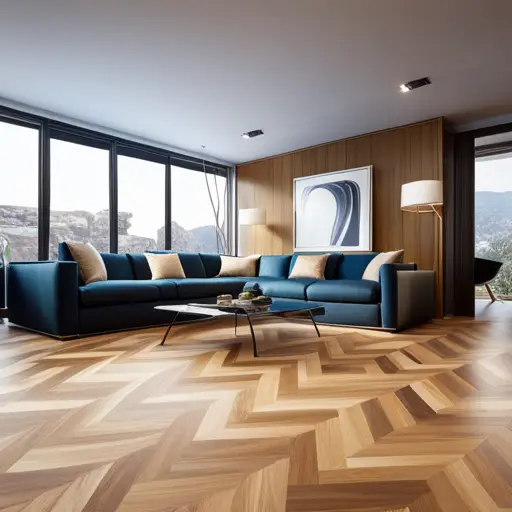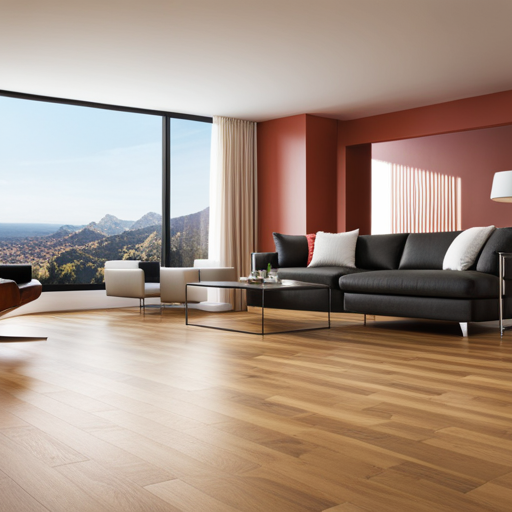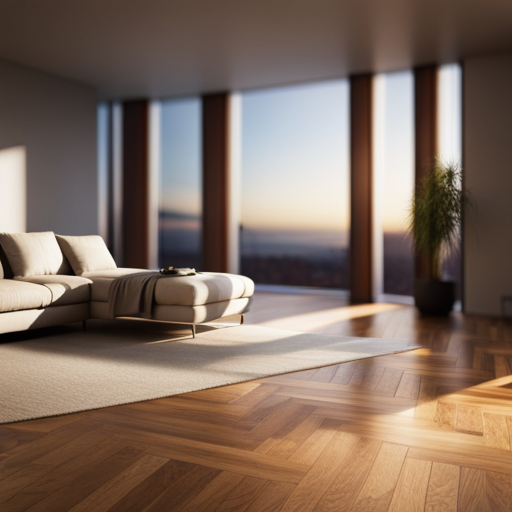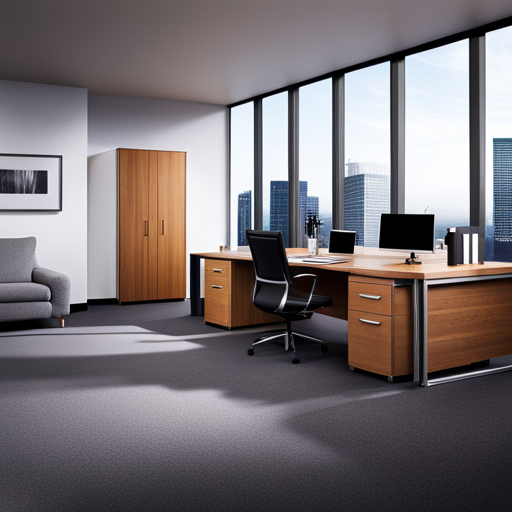The Psychology Behind Flooring Choices

The flooring choices we make in our homes and workspaces not only contribute to the aesthetic appeal but also have a profound psychological impact on our well-being and behavior.
Just as a carefully selected outfit can boost confidence and convey personal style, flooring decisions can reflect our identity and influence our emotional state.
Understanding the psychology behind flooring choices can provide valuable insights into the intricate relationship between our environment and our mental and emotional experiences.
Impact of Color and Texture
The choice of color and texture in flooring plays a significant role in influencing the psychological perception of a space.
Color psychology is a crucial factor to consider when selecting flooring, as different colors can evoke specific emotions and moods. For instance, warm tones like reds, oranges, and yellows are known to create a sense of warmth, energy, and comfort, while cool tones such as blues and greens can promote calmness and relaxation.
The use of texture in flooring also contributes to sensory perception. Smooth, glossy surfaces often reflect more light and can make a space feel more open and airy, while rougher textures can add a sense of coziness and intimacy.
Understanding the impact of color and texture on sensory perception is essential when designing spaces for specific purposes. For example, in healthcare settings, soothing and calming colors with soft, non-distracting textures can contribute to a healing environment.
Therefore, the careful consideration of color and texture in flooring choices can significantly influence the psychological experience of a space.
Connection to Emotional Well-being
Flooring choices have a direct connection to emotional well-being in various environments. The type of flooring in a space can significantly impact emotional comfort and spatial perception. For instance, carpet flooring with its soft texture and warmth can create a sense of coziness and comfort, promoting emotional well-being in living rooms and bedrooms. On the other hand, hard flooring such as wood or laminate can evoke a feeling of spaciousness and cleanliness, which may contribute to a sense of openness and freedom in an environment.
The color and pattern of the flooring also play a crucial role in affecting emotional well-being. Light-colored flooring can make a space feel more open and airy, while dark-colored flooring can create a sense of intimacy and warmth. Additionally, the tactile experience of different flooring materials can directly influence emotional comfort, as walking on certain types of flooring can evoke positive or negative emotions.
Understanding the psychological impact of flooring choices on emotional well-being is essential for creating spaces that promote positive emotions and overall well-being.
This connection between flooring choices and emotional well-being directly influences behavior and mood.
Influence on Behavior and Mood
The influence of flooring choices on behavior and mood is evident in the way different materials and textures can shape emotional responses in various environments.
For instance, the use of soft, cushioned flooring such as carpet or cork can contribute to stress relief by providing a comfortable and cozy atmosphere. Studies have shown that walking on these types of flooring materials can have a calming effect on individuals, thereby reducing stress and anxiety levels.
On the other hand, hard flooring materials like wood or laminate can create a sense of structure and stability, leading to a productivity boost in work or study environments. The firmness of these materials can help individuals feel more grounded and focused, ultimately enhancing their ability to concentrate and be productive.
Understanding the influence of flooring choices on behavior and mood is essential for creating environments that promote well-being and productivity.
This connection between flooring and emotional responses sets the stage for exploring how flooring can also influence personal identity and self-expression.
Flooring and Personal Identity
One’s choice of flooring can significantly contribute to the expression of personal identity and style, as it reflects individual preferences and influences the overall ambiance of a space. Flooring serves as a canvas for personal expression, allowing individuals to showcase their unique style preferences and create a distinctive atmosphere within their living or working environment. When considering flooring options, individuals often take into account their personal tastes and lifestyle, making deliberate choices that resonate with their identity and aesthetic sensibilities.
-
Reflecting Personal Taste: The type of flooring chosen, whether it’s hardwood, carpet, tile, or laminate, can reflect an individual’s specific design preferences and favored aesthetic.
-
Color and Texture: The color and texture of the flooring material can convey a sense of personal style, from bold and vibrant to subtle and understated choices.
-
Creating Ambiance: Flooring choices have the power to shape the overall ambiance of a space, whether it’s creating a cozy, inviting atmosphere or a sleek, modern feel that aligns with personal identity and style preference.
Social and Environmental Factors
Considerations of social and environmental factors play a pivotal role in shaping individuals’ decisions regarding flooring choices. Cultural influences and economic considerations are significant aspects that influence the selection of flooring materials and designs. Cultural influences encompass traditions, aesthetics, and societal norms, which impact the preference for specific flooring options. For instance, in some cultures, natural materials like hardwood or bamboo flooring may be favored due to their traditional significance and perceived connection to nature. On the other hand, economic considerations such as cost, maintenance, and durability also heavily influence flooring decisions. Individuals may opt for cost-effective and low-maintenance flooring options, such as laminate or vinyl, particularly in economically constrained environments. Moreover, environmental factors, including sustainability and eco-friendliness, are increasingly influencing flooring choices as individuals seek to minimize their ecological footprint. These social and environmental factors underscore the intricate interplay between personal preferences, cultural influences, economic constraints, and environmental consciousness in the decision-making process for flooring selection.
| Cultural Influences | Economic Considerations | Environmental Factors | Personal Preferences |
|---|---|---|---|
| Traditions | Cost | Sustainability | Aesthetics |
| Aesthetics | Maintenance | Eco-friendliness | Lifestyle |
| Societal norms | Durability | Eco-consciousness | Comfort |
Frequently Asked Questions
How Does Flooring Choice Impact the Perception of Room Size and Space?
Flooring choice significantly impacts the perception of room size and spatial illusion. The selection of flooring materials, patterns, and colors can visually expand or contract a room, influencing how spacious it feels to occupants.
Can Flooring Choices Affect the Acoustics and Sound Quality Within a Room?
Flooring choices significantly impact room acoustics. Materials like carpet and cork offer sound absorption, dampening echoes and improving sound quality. Hard surfaces like tile and hardwood contribute to sound reflection, potentially creating a louder and less desirable acoustic environment.
What Role Does Flooring Play in Creating a Sense of Comfort and Safety in a Space?
Flooring is integral to creating a sense of comfort and safety in a space. It impacts aesthetics and practicality, affecting how people feel in a room. The right flooring can provide a warm, inviting environment.
Are There Specific Flooring Materials That Are More Sustainable and Environmentally Friendly Than Others?
Sustainable materials in flooring, such as bamboo, cork, and reclaimed wood, offer environmentally friendly options. These materials reduce the environmental impact, contributing to a more sustainable future. Additionally, they can positively influence flooring perception and enhance space acoustics.
How Does Flooring Choice Impact Maintenance and Cleanliness in a Space?
Flooring durability directly influences maintenance and hygiene in a space. The choice of flooring impacts cleanliness by affecting ease of cleaning, resistance to wear and tear, and potential for trapping dirt and allergens.
Conclusion
In conclusion, the psychology behind flooring choices is a complex interplay of color, texture, and personal identity.
Flooring can significantly impact emotional well-being, behavior, and mood, as well as being influenced by social and environmental factors.
The phrase ‘the writing is on the wall’ emphasizes the importance of recognizing the psychological impact of flooring choices and its implications on individuals and society.

Rubin Everest, a seasoned expert in the world of flooring, brings a wealth of knowledge and passion to the surface. As the mind behind ebbow.com, Rubin is dedicated to sharing insights on the latest trends, innovative solutions, and expert advice in the realm of flooring. Whether you’re seeking practical tips for installation or design inspiration, Rubin Everest is your go-to source for all things flooring-related, making your journey to the perfect floor an informed and enjoyable experience.





